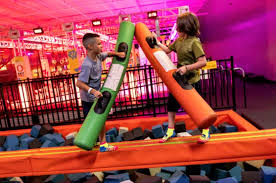Playgrounds are more than just places for children to have fun; they are also powerful environments for learning and development. Commercial Playground Equipment, when thoughtfully designed, can facilitate various types of learning experiences through play. Here's a detailed exploration of how playground equipment can support different aspects of learning while still being enjoyable for children.
Promoting Physical Development
Climbing Structures for Motor Skills
- Climbing structures, such as jungle gyms and rope courses, offer opportunities for children to develop strength, balance, and coordination. Climbing requires precise motor control and strategic planning, helping children refine their gross motor skills while having fun.
Swings for Sensory Integration
- Swinging on swings provides sensory input that supports children's vestibular and proprioceptive systems. This sensory integration helps improve body awareness, balance, and spatial orientation, which are essential skills
 for overall physical development.
for overall physical development.
Interactive Panels for Cognitive Skills
- Interactive panels with puzzles, mazes, and sensory games engage children's cognitive abilities, encouraging problem-solving, spatial reasoning, and critical thinking. These activities promote intellectual development while allowing children to explore at their own pace.
Encouraging Social and Emotional Learning
Multi-User Equipment for Collaboration
- Playground equipment designed for multiple users, such as seesaws or spinner bowls, fosters cooperation, communication, and teamwork. Children learn to negotiate roles, share responsibilities, and resolve conflicts, promoting social skills and emotional intelligence.
Role-Playing Structures for Empathy
- Play structures that mimic real-world environments, like playhouses or pretend kitchens, encourage imaginative play and role-playing. Through these activities, children learn about social roles, cultural norms, and empathy as they take on different personas and interact with their peers.
Inclusive Design for Acceptance
- Inclusive playground equipment that accommodates children of all abilities promotes acceptance and understanding. When children of diverse backgrounds and abilities play together, they learn about diversity, empathy, and inclusivity, fostering a sense of belonging and respect for others.
Supporting Cognitive Development
Educational Signage for Learning
- Playgrounds can incorporate educational signage or thematic elements that introduce concepts such as numbers, letters, shapes, or nature. These visual cues provide opportunities for incidental learning and spark curiosity, encouraging children to explore and inquire.
Nature Play Elements for Environmental Awareness
- Natural play elements like sandboxes, water features, or planters connect children with the natural world, fostering environmental awareness and stewardship. Through hands-on exploration, children learn about ecosystems, life cycles, and sustainability concepts.
Sensory Experiences for Brain Development
- Sensory-rich environments, including textures, sounds, and colors, stimulate children's senses and promote brain development. Sand and water play, musical instruments, and sensory gardens offer opportunities for children to engage their senses and make meaningful connections.
In conclusion, Commercial Playground Equipment plays a vital role in facilitating learning through play by providing diverse opportunities for physical, social, emotional, and cognitive development. By incorporating elements that engage children's interests and abilities, playgrounds become dynamic learning environments where children can explore, discover, and grow holistically.